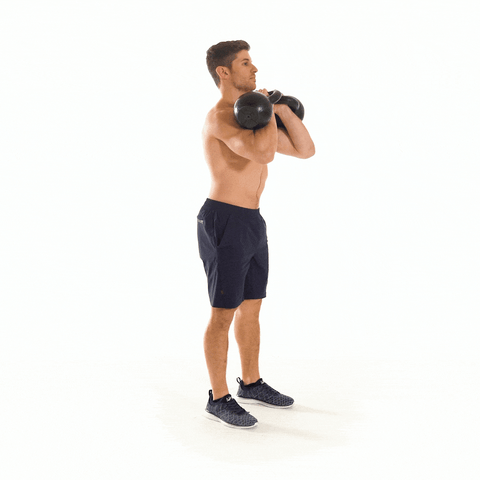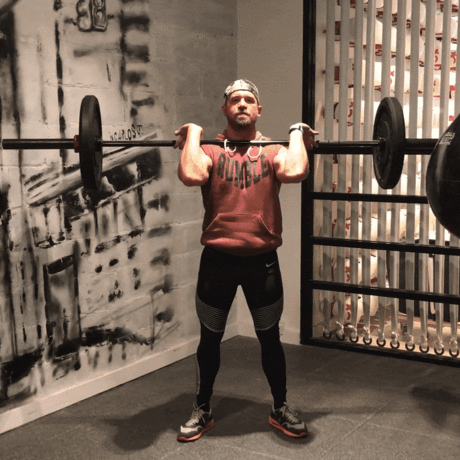
Here’s a fun way to cause some controversy: Walk into a gym, and ask five people to do a squat.
Odds are, you’re going to see five variations of the move. From where to put your feet to where you hold your weight to what type of load you’re squatting, there are a lot of moving parts to this seemingly basic exercise. Despite all the variables, however, it’s not difficult to figure out how you should be squatting — it all depends on how your body moves and what your goals are.
Still lost? Luckily, we talked to two experts to help us break down the most problematic, confusing aspects of the squat — or squatoblems, if you will.
We called up two experts, Tim DiFrancesco, PT, DPT, ATC, CSCS and Teddy Willsey, PT, DPT, CSCS to break down the three biggest squatoblems most lifters face — toe positioning, stance width, and load positioning. The trainers have worked with all sorts of athletes — from Olympians and professionals to youths and regular people just trying to get strong, so they’re well equipped to get you squatting, from the toes on up.
SQUATOBLEM 1: TOE POSITIONING
One of the biggest questions is whether or not toes should be pointed out, pointed in, or facing forward during the squat. We officially have an answer to settle it once and for all: It depends.
“Toe positioning depends on a person’s anatomy, their training goals, and ultimately, comfort,” Tim DiFrancesco, PT, DPT, ATC, CSCS told Menshealth.com.

Getty ImagesErik Isakson
DiFrancesco spent six seasons as the Head Strength and Conditioning Coach of the Los Angeles Lakers, then founded TD Athletes Edge in Salem, Massachusetts. There, he works with a wide range of athletes, not just NBA stars. No two bodies or goals ever quite the same — which means no two squats are quite the same.
First, DiFrancesco checks out anatomy and stance. Squats are all in the hips. If toes are pointed out, the hips are externally rotated; pointed parallel, the hips are in a more neutral position. Some people’s hips are more naturally inclined to externally rotate, while others are not.
Second, he considers each client’s training goals and background. “Standing with feet parallel is a more athletic position. It’s hard to generate power with the toes are splayed out,” DiFrancesco said. With that said, however, toes pointed out can enable a deeper squat, which comes with its own set of benefits.
Finally, comfort. “If a person naturally walks with their toes pointed out, they’re probably going to squat better with their toes out,” DiFrancesco said. If a person tries squatting parallel and their feet cave in, they may be better off turning their toes slightly outwards. On the other hand, if you’re more comfortable with your toes parallel, and can do it with good form, then opt for your toes facing parallel.
SQUATCLUSION: LISTEN TO YOUR BODY
Your toe position all depends on your body. Find the position that works best for you and aligns best with your training goals, not anyone else’s.
SQUATOBLEM 2: HOW WIDE WILL YOU GO?
Once your toes are in place, where should you actually put your feet? Shoulder-width? Wider, or narrower? There are three basic widths in the squat — medium/neutral, wide, and narrow. And yes, there’s actually a time and place for each.
First, the medium/neutral squat. This width is about hip-width apart. Much like the parallel toe positioning, the hip-width squat is more appropriate for increasing athletic performance, simply because it’s a more athletic position according to DiFrancesco. “You might be able to lift more weight by widening your stance, but if your goal is athletic performance and not strictly hypertrophy [the cellular process that grows muscle], you’re sacrificing those goals by going wider,” he said.

Getty ImagesJohn Lund
The wider squat, also called a sumo squat, is when the feet come much wider than hip width apart. In this position, toes are almost always slightly pointed out. “It’s much easier to get depth and keep your chest upright with the sumo variation,” DiFrancesco said. “If it’s hard for a person to get low and keep their chest upright when they try a hip-width squat, this can make things easier.”
The wide squat stance also encourages more glute activation, and people can usually tolerate heavier weight with a wider stance.
Finally, the narrow squat, which is when the feet are narrower than hip width. This position is not nearly as popular as the other two, and for a pretty obvious reason — it’s an extremely challenging exercise to do properly.
“Narrow squats are much harder to control,” DiFrancesco said, “This squat really highlights hip, ankle, and upper back mobility issues. A lot of people usually have some sort of issue with one of those things. But if they don’t, then they could probably do these right. I don’t typically program these into my workouts.”
SQUATCLUSION: PICK THE STANCE THAT’S COMFORTABLE… AND ALIGNS WITH YOUR GOALS
Ultimately, much like toe positioning, it’s important to listen to your body when figuring out your squat stance’s width. If you’re comfortable with multiple positions, however, think about your goals — if strictly building strength and muscle mass is the target, a wider squat will help you out. If it’s athletic performance, hip-width is your best bet, and if you’re looking for a new way to progress in your squats after mastering the other two positions, give the narrow stance a try.
SQUATOBLEM 3: LOAD POSITIONING
If you look around the gym at all the guys doing squats, odds are they’re all holding their weights in a different spot, and all with a different type of weight — we’re talking barbells, dumbbells, kettlebells in all sorts of interesting positions on the body. For this, we’re going to stick to the most common holds — goblet, shoulder, back rack, and front rack.
Goblet


Men's Health
First, the goblet hold, which is when a person is holding their weight in front of their chest. This is typically done with either a dumbbell or a kettlebell, and is a great starting position for learning squat mechanics. “When I’m teaching someone how to squat, I almost always start them out with a goblet hold with about 10-15 pounds of weight,” said Teddy Willsey, PT, DPT, CSCS. “With a bodyweight squat, you lean forward a lot. But if you have that extra weight in front of your chest, you’re able to better balance your weight over your feet instead of leaning forward and bringing your torso over your feet.”
Willsey, owner of Healthy Baller Physical Therapy in Rockville, Maryland, has coached thousands of athletes on proper squat form — everyone from Olympians to professionals to first-time lifters. He swears by the power of the goblet squat.
“The only time I’d advise someone to progress out of the goblet is because they need to add more weight than their arms can hold,” he said.
To add more weight beyond a goblet squat, you need to load up a barbell. But where you hold that barbell depends completely on what area of your body you’re trying to work.
Shoulder


Men's Health
Like the barbell positions, the shoulder hold, which involves either two dumbbells or two kettlebells held on top of either shoulder, mostly just allows for more weight to be squatted than the goblet hold, and requires a bit more control to keep yourself from leaning too far forward. “When the dumbbells come above shoulder height, there’s more work that goes into controlling the lumbar spine,” DiFrancesco said, “Some people with low back or lumbar spine problems probably wouldn’t like this. However, if it’s tolerated well, it can be a great way to progress to the barbell front rack position.”
Back Rack


Men's Health
The first of the barbell positions, the back rack, is when the barbell is supported on the upper back. This is likely what you see most guys at the gym doing, and it’s pretty easy to figure out why — people can tolerate a lot of weight on the bar because it works more of the back, glutes, hips, and hamstrings. Big leg muscles squat big things.
Back rack can either be performed from a high-bar or low-bar position. High-bar, with the load perched on top of the shoulders and the back of the neck, are preferred by athletes. Low-bar drops the position down a few inches to the posterior delts, allows powerlifters to handle more weight than in the standard high-bar position.
Front Rack


Men's Health
The front rack, on the other hand, works the front of the body — think core and quads. For this, the shoulders and chest are supporting the bar. “I don’t think I can really say that one is better than the other,” Willsey said, “It really depends on what you want to focus on that day. Back rack will work more of the back of the body, and front rack will hit more of the front. Both are important.”
SQUATCLUSION: PROGRESS SMART
If you’re relatively new to squatting, using light resistance in the goblet hold can help train your body to keep your core and back tight during the movement. Continue to add weight to your goblet squat, and when the weight becomes too much for your arms, you’re probably ready to try out the back and front rack squat variaties. As always, however, listen to how your body responds to different positions, and make sure that form is perfect before you add weight. Then you can start thinking about things like your squat depth and how you can safely fail a rep without getting crushed.
The squat is one of the first moves in the weight room you should be committed to mastering. “Most people should be squatting if they work out,” Willsey said. But don’t just blindly follow what the guy standing next to you is doing — focus on figuring out the move, starting from the bottom up. Then think about what you’re trying to accomplish, and decide which method works best for you. Finally, make sure to get completely comfortable with one lifting position before progressing to the next — progressing too quickly can easily lead to injury. Do it smart, however, and the gains will follow.
Source: Read Full Article
